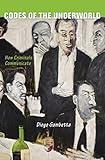Codes of the Underworld : How Criminals Communicate / Diego Gambetta.
Material type: TextPublisher: Princeton, NJ : Princeton University Press, [2011]Copyright date: ©2009Description: 1 online resource (368 p.) : 5 line illus. 3 tablesContent type:
TextPublisher: Princeton, NJ : Princeton University Press, [2011]Copyright date: ©2009Description: 1 online resource (368 p.) : 5 line illus. 3 tablesContent type: - 9780691152479
- 9781400833610
- 364.301/4
- online - DeGruyter
- Issued also in print.
| Item type | Current library | Call number | URL | Status | Notes | Barcode | |
|---|---|---|---|---|---|---|---|
 eBook
eBook
|
Biblioteca "Angelicum" Pont. Univ. S.Tommaso d'Aquino Nuvola online | online - DeGruyter (Browse shelf(Opens below)) | Online access | Not for loan (Accesso limitato) | Accesso per gli utenti autorizzati / Access for authorized users | (dgr)9781400833610 |
Browsing Biblioteca "Angelicum" Pont. Univ. S.Tommaso d'Aquino shelves, Shelving location: Nuvola online Close shelf browser (Hides shelf browser)

|

|

|

|

|

|

|
||
| online - DeGruyter The Princeton Encyclopedia of American Political History. (Two volume set) / | online - DeGruyter The Invention of Enterprise : Entrepreneurship from Ancient Mesopotamia to Modern Times / | online - DeGruyter Power over Peoples : Technology, Environments, and Western Imperialism, 1400 to the Present / | online - DeGruyter Codes of the Underworld : How Criminals Communicate / | online - DeGruyter Brahms and His World : Revised Edition / | online - DeGruyter The Philosophy of the Enlightenment : Updated Edition / | online - DeGruyter C. P. Cavafy : Collected Poems - Bilingual Edition / |
Frontmatter -- Contents -- Acknowledgments -- Introduction -- Abbreviations -- PART 1. Costly Signals -- 1. Criminal Credentials -- 2. The Power of Limits -- 3. Information as Hostage -- 4. Why Prisoners Fight (and Signal) -- 5. Self-harm as a Signal -- PART 2. Conventional Signals -- 6. Conventional and Iconic Signals -- 7. Protecting Easy-to-Fake Signals -- 8. Criminal Trademarks -- 9. Nicknames -- 10. Why (Low) Life Imitates Art -- Notes -- Bibliography -- Index
restricted access online access with authorization star
http://purl.org/coar/access_right/c_16ec
How do criminals communicate with each other? Unlike the rest of us, people planning crimes can't freely advertise their goods and services, nor can they rely on formal institutions to settle disputes and certify quality. They face uniquely intense dilemmas as they grapple with the basic problems of whom to trust, how to make themselves trusted, and how to handle information without being detected by rivals or police. In this book, one of the world's leading scholars of the mafia ranges from ancient Rome to the gangs of modern Japan, from the prisons of Western countries to terrorist and pedophile rings, to explain how despite these constraints, many criminals successfully stay in business. Diego Gambetta shows that as villains balance the lure of criminal reward against the fear of dire punishment, they are inspired to unexpected feats of subtlety and ingenuity in communication. He uncovers the logic of the often bizarre ways in which inveterate and occasional criminals solve their dilemmas, such as why the tattoos and scars etched on a criminal's body function as lines on a professional résumé, why inmates resort to violence to establish their position in the prison pecking order, and why mobsters are partial to nicknames and imitate the behavior they see in mafia movies. Even deliberate self-harm and the disclosure of their crimes are strategically employed by criminals to convey important messages. By deciphering how criminals signal to each other in a lawless universe, this gruesomely entertaining and incisive book provides a quantum leap in our ability to make sense of their actions.
Issued also in print.
Mode of access: Internet via World Wide Web.
In English.
Description based on online resource; title from PDF title page (publisher's Web site, viewed 29. Jul 2021)


